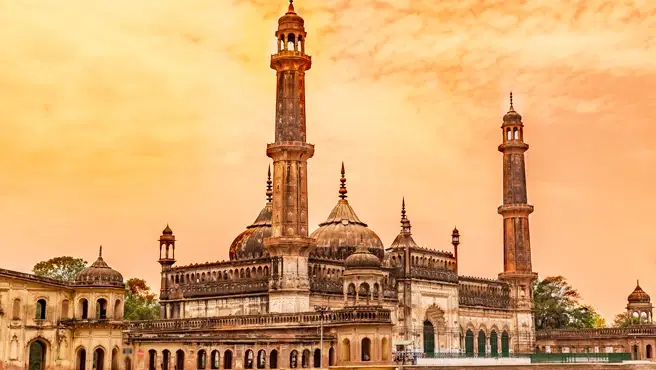
Hotels
•04 min read

Step into a world of history. Akbar Fort in Allahabad stands as a grand reminder of India's rich past. This magnificent fort, set on the banks of the sacred Ganges and Yamuna rivers, gleams with Mughal glory. Its imposing structure and intricate details speak of a bygone era when art and architecture met power and purpose.
In this blog, we uncover the secrets of Akbar Fort in Allahabad. We explore its illustrious history and its standout architectural features. Readers will learn about the fort's origin, how it shaped events over centuries, and the significance it holds as one of the most revered Mughal heritage sites in India. This post answers frequently asked questions on the fort's history, architecture, and visitor details.
Emperor Akbar built the fort to establish a strong presence in northern India. Strategically placed near the confluence of the Ganges and Yamuna, the fort served a dual purpose. It was a center for trade and governance. It also helped consolidate Mughal power in the region. With a clear vision, Akbar aimed to create a space that was both defensible and majestic, which is reflected in the fort's enduring beauty.
The corridors of Akbar Fort have seen many pivotal moments. One of the major episodes was Prince Salim's rebellion. Later, the fort shifted hands during the British East India Company's expansion. Each event added layers to its history. Today, the fort is a symbol of resilience and change, telling stories from the Mughal era to colonial times.
The design of Akbar Fort is a testament to Mughal ingenuity. Builders used the finest materials and craftsmanship. The fort's layout is carefully planned, blending functionality with beauty. Visitors can admire landmarks like the Ashoka Pillar. This ancient structure dates back to the 3rd century BCE. The Saraswati Koop and hidden underground temples add a mysterious charm to the place.
Insight Corner: "Did You Know? The Allahabad Fort houses the Ashoka Pillar, an ancient artifact dating back to the 3rd century BCE, making it a blend of Mughal and pre-Mughal heritage."

Akbar Fort compares uniquely with other Mughal forts across India. For instance, Agra Fort and Red Fort share similar Mughal architecture. Yet, Akbar Fort stands out with its strategic riverside location. While Agra Fort served as the heart of Mughal administration, and Red Fort symbolized royal power in Delhi, Akbar Fort in Allahabad tells a story of both defense and diplomacy. Its design incorporates local traditions and Mughal influences, making it a true architectural marvel.
The fort is more than just stone and mortar. It is an emblem of cultural pride for the people of Prayagraj. Over centuries, the fort has influenced local traditions and customs. The site has always drawn pilgrims, intellectuals, and curious travelers. Today, its presence adds to the charm of the city. It continues to be a destination for tourists and history enthusiasts alike.
Even after centuries, efforts are in place to preserve Akbar Fort in Allahabad. Parts of the fort stay restricted, as they now serve a military function. The Indian Army oversees these sections. The Archaeological Survey of India works hard to maintain its historical integrity. Their work ensures that the fort's Story is not lost over time. Preserving this monument is crucial to maintaining India's cultural heritage.
Visitors planning a trip to Akbar Fort in Allahabad need essential details. The fort is located in the heart of Prayagraj, easily accessible to travelers. Open hours are set to welcome history lovers each day. A ticket fee grants access to select sections of the fort. When you visit, consider pairing it with a trip to nearby attractions. Triveni Sangam, the holy confluence of rivers, and Anand Bhavan, another historical marvel, complete the experience.
Timing plays an important role when exploring historical sites. The best time to visit is during the cooler months. Mild weather allows you to wander comfortably around the expansive fort. Early mornings and late afternoons offer softer light and fewer crowds. This way, you can soak in the marvels of Akbar's architectural achievements at your own pace, enjoying every moment of discovery.
Akbar built the fort at the confluence of the rivers to strengthen trade and governance in northern India.
Yes, certain areas of the fort are open for public visits while others remain restricted.
The fort is partly closed due to its use as a military base under the control of the Indian Army.
Built in 1583, the Allahabad Fort was constructed by Emperor Akbar and is a hallmark of his architectural prowess.
The fort showcases the Ashoka Pillar, Saraswati Koop, and underground temples, each holding deep historical and spiritual value.
Conclusion
Akbar Fort in Allahabad is a living testament to India's turbulent yet fascinating history. The fort's ability to connect epochs is seen in its walls, which bear witness to the passage of time. It remains a vital part of Allahabad's heritage and continues to inspire both scholars and travelers. The blend of Mughal elegance with local artistry makes it a symbol of unity and change.
For anyone passionate about heritage sites and the rich tapestry of Indian history, Akbar Fort in Allahabad offers a compelling journey. The fort is not only a reminder of the power and vision of Akbar but also a symbol of the continuous evolution of Indian architecture. Its strategic placement, innovative design, and deep cultural roots create a narrative that touches the heart of every visitor.
In summary, exploring Akbar Fort in Allahabad is like walking through a history book brought to life. The stories woven into its structure speak of mighty empires and celebrated leaders. Whether you are a history buff, an architecture enthusiast, or simply a curious traveler, the fort is sure to leave you inspired. Let the rich history and architectural marvels of this site guide you on an unforgettable journey through time.